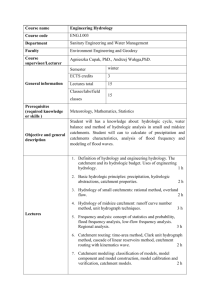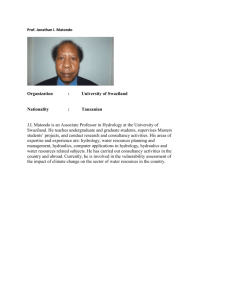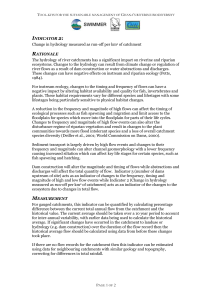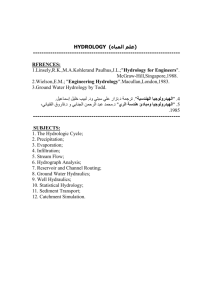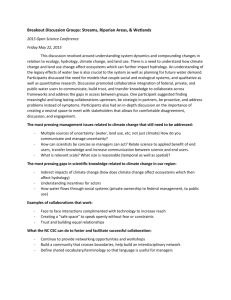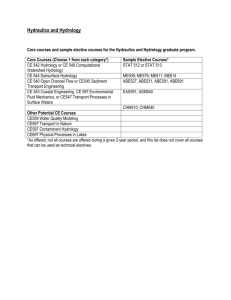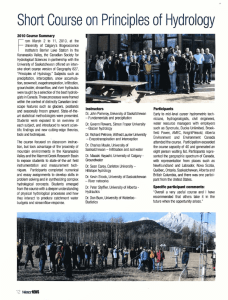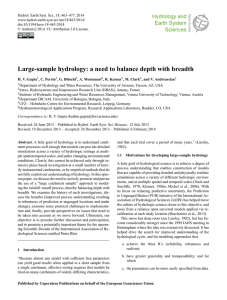On the future of forest hydrology and biogeochemistry INVITED COMMENTARY
advertisement
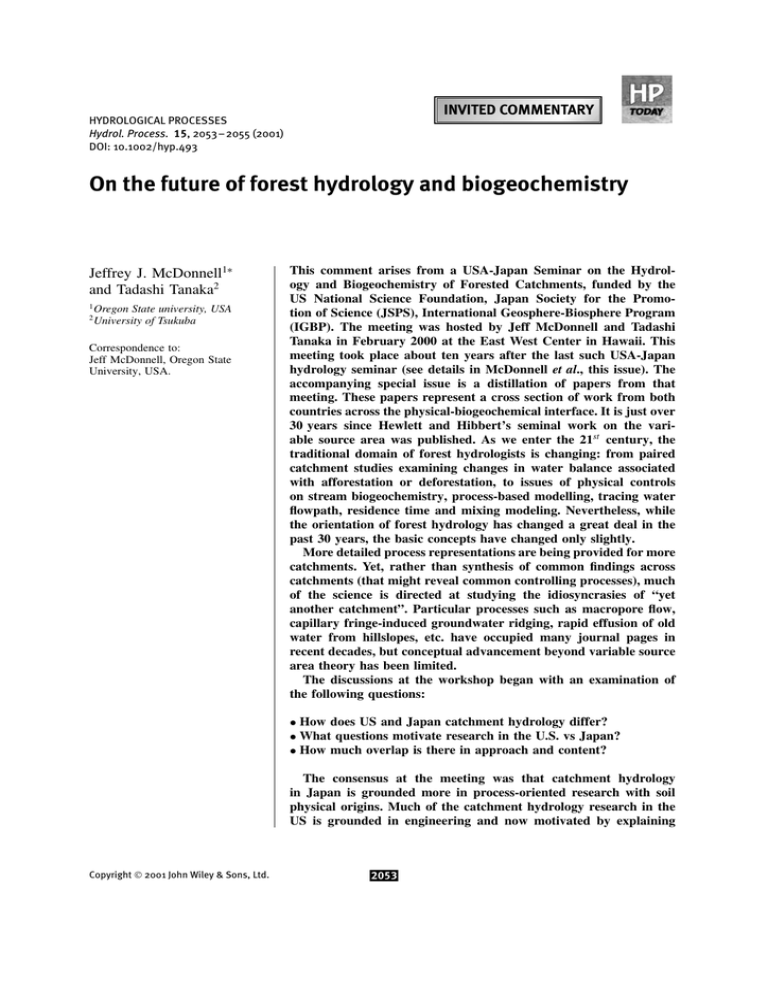
INVITED COMMENTARY HYDROLOGICAL PROCESSES Hydrol. Process. 15, 2053–2055 (2001) DOI: 10.1002/hyp.493 On the future of forest hydrology and biogeochemistry Jeffrey J. McDonnell1Ł and Tadashi Tanaka2 1 2 Oregon State university, USA University of Tsukuba Correspondence to: Jeff McDonnell, Oregon State University, USA. This comment arises from a USA-Japan Seminar on the Hydrology and Biogeochemistry of Forested Catchments, funded by the US National Science Foundation, Japan Society for the Promotion of Science (JSPS), International Geosphere-Biosphere Program (IGBP). The meeting was hosted by Jeff McDonnell and Tadashi Tanaka in February 2000 at the East West Center in Hawaii. This meeting took place about ten years after the last such USA-Japan hydrology seminar (see details in McDonnell et al., this issue). The accompanying special issue is a distillation of papers from that meeting. These papers represent a cross section of work from both countries across the physical-biogeochemical interface. It is just over 30 years since Hewlett and Hibbert’s seminal work on the variable source area was published. As we enter the 21st century, the traditional domain of forest hydrologists is changing: from paired catchment studies examining changes in water balance associated with afforestation or deforestation, to issues of physical controls on stream biogeochemistry, process-based modelling, tracing water flowpath, residence time and mixing modeling. Nevertheless, while the orientation of forest hydrology has changed a great deal in the past 30 years, the basic concepts have changed only slightly. More detailed process representations are being provided for more catchments. Yet, rather than synthesis of common findings across catchments (that might reveal common controlling processes), much of the science is directed at studying the idiosyncrasies of “yet another catchment”. Particular processes such as macropore flow, capillary fringe-induced groundwater ridging, rapid effusion of old water from hillslopes, etc. have occupied many journal pages in recent decades, but conceptual advancement beyond variable source area theory has been limited. The discussions at the workshop began with an examination of the following questions: ž How does US and Japan catchment hydrology differ? ž What questions motivate research in the U.S. vs Japan? ž How much overlap is there in approach and content? The consensus at the meeting was that catchment hydrology in Japan is grounded more in process-oriented research with soil physical origins. Much of the catchment hydrology research in the US is grounded in engineering and now motivated by explaining Copyright 2001 John Wiley & Sons, Ltd. 2053 J. MCDONNELL AND T. TANAKA stream water chemistry. Major features distinguishing Japanese forest catchments from those of the northeast US are generally higher temperature, greater precipitation, and steeper topography. Among these, Japanese researchers especially emphasized the importance of the steeper topography for understanding runoff processes. It was also recognized that in the high relief catchments, it is important to consider the infiltration processes of subsurface water into the bedrock and of the bedrock flow during storm events. Although there have been few reports to date concerning the role of bedrock flow during storm events, it is expected that this will be a fruitful area for future study. Discussion then centered on the following questions: ž What are the models we believe best express our understanding of catchment hydrology and catchment biogeochemistry? ž What are the major advances that have taken place over the past two decades in terms of field observations, hydrological theory/computer methods? ž Where are the big holes/gaps in our knowledge/ models? ž How does measurement and model uncertainty affect the way forward? While several of these questions went unresolved at the meeting, participants discussed in some detail what holes in our knowledge still exist. Among the most important outstanding questions included: ž How can we objectively separate and identify the dominant flow pathways and sources to streamflow and chemistry? ž What is the role of vegetation and biology on weathering rates and other reactions? ž How can we scale-up our process knowledge? ž What are the important preferential flowpaths in the unsaturated zone? ž How does flow in the bedrock contribute to runoff composition? ž How can we characterize the hillslope-riparian zone interface? Copyright 2001 John Wiley & Sons, Ltd. Questions discussed at the meeting then moved on to: ž How do we translate to larger scales knowledge and models of what occurs at the profile and hillslope scale? ž Are hillslope chemical signatures “re-set” in the near-stream zone? ž To what extent should we focus on hillslope or near-stream processes to explain geochemical flux into receiving waters? ž What does the field evidence indicate regarding representative elementary areas? ž What are the averaging lengths for water flowpaths in catchments? ž How can we improve process descriptions without introducing more parameter identifiability problems? and finally, ž What are the key state variables that we must identify in combined forest hydrology/biogeochemistry models? The task that the group identified for itself (and for the international forest hydrology community) over the next few years is to go forth and develop testable hypotheses for comparative catchment analysis in forest hydrology. Other important questions for hypothesis development and testing are the separation and identification of dominant flow pathways and water sources and the quantification of the role of vegetation and biology on weathering rates and other reactions. The issue of small scale understanding in previously paired watershed study catchments versus the large scale prediction imperative continues to challenge the way forward. Finally, perhaps the most important dialogue across the physical-biogeochemical interface, as well as the experimental-model interface is to develop new measurements to reduce model and parameter uncertainty. While these challenges will be difficult, they are surmountable and perhaps provide a road map for studies in the field for the next few years. Certainly, the papers in this issue might be viewed as examples of where these new approaches are being 2054 Hydrol. Process. 15, 2053–2055 (2001) INVITED COMMENTARY attempted in the US and Japan. Perhaps the next USA-Japan meeting (in ten years?) might be able Copyright 2001 John Wiley & Sons, Ltd. to assess how many of these areas have been advanced! 2055 Hydrol. Process. 15, 2053–2055 (2001)
